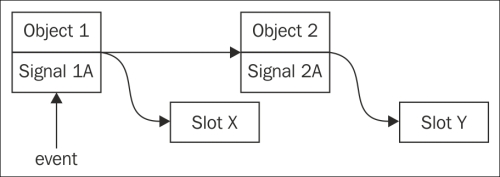Signal Slot Qt Connect
My Problem is that the SIGNAL comes from the Dialog with the name onpushButtonEnterclicked and my SLOT is inside my mainwindow with the name setCurrentIndex. I,ve read the post's: 'How to Connect Signal from MainWindow to Slot in Dialog' and 'Qt connect mainwindow and dialog using signal and slot'. A developer can choose to connect to a signal by creating a function (a slot) and calling the connect function to relate the signal to the slot. Qt's signals and slots mechanism does not require classes to have knowledge of each other, which makes it much easier to develop highly reusable classes.
One key and distinctive feature of Qt framework is the use of signals and slots to connect widgets and related actions. But as powerful the feature is, it may look compelling to a lot of developers not used to such a model, and it may take some time at the beginning to get used to understand how to use signals and slots properly. However, since version 4.4, we can relay on auto-connections to simplify using this feature. Back in the old days, signals and slots connections were set up for compile time (or even run time) manually, where developers used the following sentence:
Back in the old days, signals and slots connections were set up for compile time (or even run time) manually, where developers used the following sentence:this is, we stated the sender object's name, the signal we want to connect, the receiver object's name and the slot to connect the signal to.
Now there's an automatic way to connect signals and slots by means of QMetaObject's ability to make connections between signals and suitably-named slots. And that's the key: if we use an appropriate naming convention, signals and slots will be properly connected without the need to write additional code for that to happen. So by declaring and implementing a slot with a name that follows the following convention:

uic
 (the User Interface Compiler of Qt) will automatically generate code in the dialog's setupUi() function to connect button's signal with dialog's slot.
(the User Interface Compiler of Qt) will automatically generate code in the dialog's setupUi() function to connect button's signal with dialog's slot.So back to our example, the class implementing the slot must define it like this:
 We then write the method's implementatio to carry on an action when the signal is emitted:
We then write the method's implementatio to carry on an action when the signal is emitted:In brief, we have seen that by using automatic connection of signals and slots we can count on both a standard naming convention and at the same time an explicit interface for designers to embrace. If the proper source code implements such a given interface, interface designers can later check that everything is working fine without the need to code.
This page describes the use of signals and slots in Qt for Python.The emphasis is on illustrating the use of so-called new-style signals and slots, although the traditional syntax is also given as a reference.
The main goal of this new-style is to provide a more Pythonic syntax to Python programmers.
- 2New syntax: Signal() and Slot()
Traditional syntax: SIGNAL () and SLOT()
QtCore.SIGNAL() and QtCore.SLOT() macros allow Python to interface with Qt signal and slot delivery mechanisms.This is the old way of using signals and slots.
The example below uses the well known clicked signal from a QPushButton.The connect method has a non python-friendly syntax.It is necessary to inform the object, its signal (via macro) and a slot to be connected to.
New syntax: Signal() and Slot()
The new-style uses a different syntax to create and to connect signals and slots.The previous example could be rewritten as:
Using QtCore.Signal()
Signals can be defined using the QtCore.Signal() class.Python types and C types can be passed as parameters to it.If you need to overload it just pass the types as tuples or lists.
In addition to that, it can receive also a named argument name that defines the signal name.If nothing is passed as name then the new signal will have the same name as the variable that it is being assigned to.
The Examples section below has a collection of examples on the use of QtCore.Signal().
Note: Signals should be defined only within classes inheriting from QObject.This way the signal information is added to the class QMetaObject structure.
Using QtCore.Slot()
Slots are assigned and overloaded using the decorator QtCore.Slot().Again, to define a signature just pass the types like the QtCore.Signal() class.Unlike the Signal() class, to overload a function, you don't pass every variation as tuple or list.Instead, you have to define a new decorator for every different signature.The examples section below will make it clearer.
Another difference is about its keywords.Slot() accepts a name and a result.The result keyword defines the type that will be returned and can be a C or Python type.name behaves the same way as in Signal().If nothing is passed as name then the new slot will have the same name as the function that is being decorated.
Examples
The examples below illustrate how to define and connect signals and slots in PySide2.Both basic connections and more complex examples are given.
- Hello World example: the basic example, showing how to connect a signal to a slot without any parameters.
- Next, some arguments are added. This is a modified Hello World version. Some arguments are added to the slot and a new signal is created.
- Add some overloads. A small modification of the previous example, now with overloaded decorators.
- An example with slot overloads and more complicated signal connections and emissions (note that when passing arguments to a signal you use '[]'):
Qt Signal Slot Direct Connection
- An example of an object method emitting a signal:
- An example of a signal emitted from another QThread:
Qt Automatic Signal Slot Connection
- Signals are runtime objects owned by instances, they are not class attributes: